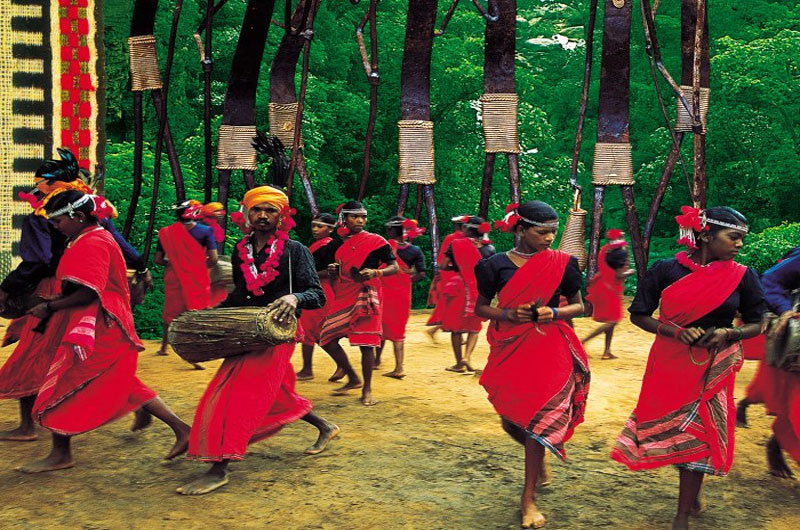
Festivals of Chhattisgarh
Chhattisgarh, known for its rich cultural heritage and tribal traditions, celebrates a variety of festivals that reflect its vibrant cultural diversity. These festivals are marked by colorful rituals, traditional dances, music, and a deep sense of community spirit.
Bastar Dussehra
Time of Festival
- October
Specialty of the Festival
- Significance: Unique tribal celebration of Dussehra lasting over a fortnight.
- Activities: Worship of local deities, traditional dances (e.g., Bison Dance), and ceremonial processions.
Locality of the Festival
- Celebrated in: Bastar district, with Jagdalpur as the main center.
Nature of the Festival
- Type: Cultural and religious
- Description: Bastar Dussehra is a significant tribal festival celebrated with great fervor in Chhattisgarh, particularly among the indigenous tribes of Bastar. Unlike the traditional Dussehra, this festival spans over a period of 10-15 days. It involves the worship of local deities by tribal communities, accompanied by elaborate rituals and cultural performances. The highlight of the festival is the Bison Dance (Ghotul Nritya), where men adorned as bison dance to the beats of traditional music. The festival culminates in a grand procession with idols of deities carried on chariots amidst chanting and festivities.
Madai Festival
Time of Festival
- Throughout the Year (Specific dates vary)
Specialty of the Festival
- Significance: Worship of village deities for prosperity and well-being.
- Activities: Animal sacrifices, traditional rituals, and cultural performances.
Locality of the Festival
- Celebrated Across: Various villages and towns of Chhattisgarh, notably in Dhamtari, Kondagaon, and Raigarh districts.
Nature of the Festival
- Type: Cultural and religious
- Description: Madai Festival is celebrated by several tribal communities in Chhattisgarh throughout the year, with specific dates varying from village to village. It is dedicated to the worship of local village deities believed to protect and bless the community with prosperity and well-being. The festival involves elaborate rituals performed by tribal priests, including animal sacrifices as offerings to the deities. Cultural performances such as traditional dances, folk music, and dramas depicting mythological tales are integral parts of the celebrations. Madai Festival showcases the rich cultural heritage and communal harmony among Chhattisgarh’s tribal communities.
Hareli Festival
Time of Festival
- July or August
Specialty of the Festival
- Significance: Agricultural festival celebrating the arrival of the monsoon and sowing season.
- Activities: Rituals for a good harvest, folk dances (e.g., Panthi Dance), and community feasts.
Locality of the Festival
- Celebrated Across: Chhattisgarh, especially in rural areas and farming communities.
Nature of the Festival
- Type: Agricultural and cultural
- Description: Hareli Festival is an agricultural festival celebrated with enthusiasm in Chhattisgarh, particularly among farmers and rural communities. It marks the arrival of the monsoon season and the beginning of the sowing of crops. The festival is dedicated to Goddess Khermai, the deity of agriculture and fertility, worshipped for a bountiful harvest. Farmers perform rituals and prayers to bless their fields and ensure a prosperous agricultural season. Panthi Dance, a traditional folk dance of Chhattisgarh, is performed during Hareli Festival, depicting the joy and festivities associated with farming and nature. Community feasts featuring local delicacies are also organized to celebrate the occasion.
Pola Festival
Time of Festival
- August
Specialty of the Festival
- Significance: Dedicated to the worship of bulls for their role in agriculture and farming.
- Activities: Decorated bull processions, bull races (Bailgada), and traditional rituals.
Locality of the Festival
- Celebrated Across: Rural areas and villages of Chhattisgarh, notably in Bilaspur, Durg, and Rajnandgaon districts.
Nature of the Festival
- Type: Agricultural and cultural
- Description: Pola Festival is a unique agricultural festival celebrated primarily by farmers in Chhattisgarh to honor and worship bulls for their crucial role in farming and agriculture. Bulls are considered sacred animals and symbols of strength and prosperity. On Pola day, farmers decorate their bulls with colorful ornaments, garlands, and paint markings on their horns. Special processions of decorated bulls are taken through villages amidst cheers and traditional music. Bull races, known as Bailgada, are organized where bulls demonstrate their strength and agility. The festival also includes rituals and prayers performed by farmers to seek blessings for their livestock and agricultural prosperity.
Navakhai Festival
Time of Festival
- August or September
Specialty of the Festival
- Significance: Harvest festival celebrating the first rice crop of the season.
- Activities: Offering of new rice (Nua Dhan), cultural programs, and community feasts.
Locality of the Festival
- Celebrated Across: Various regions of Chhattisgarh, especially among agrarian communities.
Nature of the Festival
- Type: Agricultural and cultural
- Description: Navakhai Festival is a harvest festival celebrated with great joy and enthusiasm in Chhattisgarh, marking the first rice crop of the season. It is a time of thanksgiving to the deities for a successful harvest and blessings for future agricultural prosperity. Farmers offer the first grains of new rice, known as Nua Dhan, to their deities as a token of gratitude. Cultural programs featuring traditional dances, music performances, and dramas are organized to showcase the cultural heritage of Chhattisgarh. Community feasts are an integral part of Navakhai celebrations, where people gather to savor delicious local dishes and sweets prepared from the freshly harvested rice.
These festivals of Chhattisgarh highlight the state’s vibrant cultural traditions, deep-rooted beliefs, and agricultural heritage, making them significant celebrations that attract locals and tourists alike.
